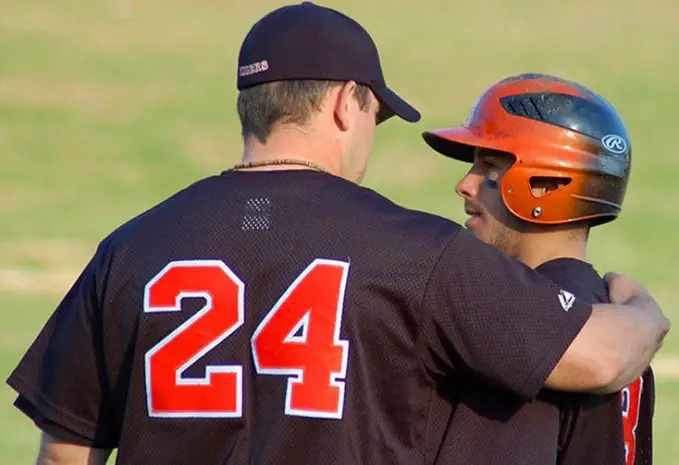Table of Contents
Conflict occurs in sports of all types and at all levels, even in social sports. It’s important for coaches to know how to resolve conflicts when they arise. Coaches must also know how to recognize conflict when it strikes. Having an understand of conflict will aid the coach in staying fair and empathizing with their players.
Conflict is caused by personal dislike, jealousy, and a difference in people’s values, behaviors, desires, and interests. Below we have covered some of the top conflict resolution techniques to use in sports.
*This post may contain affiliate links. As an Amazon Associate we earn from qualifying purchases.
1. Win-Win

The win-win conflict resolution technique attempts to find a solution that satisfies both sides. This conflict resolution technique is also referred to as collaborating, problem solving, and problem confronting. To implement win-win, one must detect the underlying concerns of both sides and find a solution that addresses each party’s concerns.
Win-win is helpful when commitment and consensus of both sides is important. It’s also beneficial for teams because long-term relationships between the players in the sport is important. Situations in which the win-win approach isn’t helpful include when a fast solution is needed and when one side has lost trust in the other.
2. Compromising
Compromising seems similar to win-win because the goal is to find a solution that satisfies both sides of the conflict. However, it is sometimes lose-lose. Compromising is intended for situations in which there isn’t sufficient time to go through the in-depth process of win-win conflict resolution.
It can be used to find a temporary solution to complicated issues. Compromising is also suitable when the team hasn’t developed trust among each other yet. Something crucial to remember about compromising is it may require monitoring to ensure both parties keep their end of the agreement.
3. Avoiding
In some situations, avoiding is one of the best conflict resolution techniques because the issue is trivial. Other scenarios in which avoiding, also referred to as withdrawing, are appropriate include when there are more pressing issues, delaying a response is beneficial, one is too emotionally involved to handle the conflict, and others could solve it better. When the other party is hostile, it is also sometimes a good idea to temporarily withdraw.
Remember that withdrawal doesn’t have to be a permanent solution to the conflict. One may address it again at a later date using one of the other top conflict resolution techniques. Potential downsides of avoiding are the other party perceiving it as agreement and your relationship being negatively affected with those who expect action.
4. Smoothing
Another one of the top conflict resolution techniques to use in sports is smoothing, also referred to as accommodating. One satisfies the concerns of the other party before their own with the smoothing technique. Smoothing is good when the situation is more important to the other person, one is wrong, and buy time until one is in a better position to respond.
What one must be aware of with the smoothing technique is the other party sometimes tries to take advantage of them if they use it too often. Smoothing could also hurt one’s confidence in their ability to handle aggression from the opposing side. And it can make it more difficult to aim for a win-win situation the next time a conflict arises or if the same one is addressed again to find a permanent solution.
5. Forcing
Sometimes, a situation in sports calls for forcing, also known as competing. It is one of the most effective conflict resolution techniques in life-threatening situations and brawls. If one or both parties have become too aggressive, then forcing is probably the conflict resolution method one should use. Aggressive situations need to be put out as quickly as possible before someone gets seriously injured. When emotions are that high, resolution techniques like win-win are simply not effective.
Forcing involves pursing one’s own concerns despite resistance from the other party. This technique can also be used to resolve conflicts that have been going on for a long time and have failed to be resolved be the other conflict resolution techniques. Forcing can increase one’s self-esteem and draw respect from others as long as it was an appropriate response to an aggressive conflict. A potential downside of forcing to be aware of include negatively affecting one’s relationship with the opposition. Some people feel drained of energy when they use forcing as well.
6. Broadcast Praise

Broadcasting praise is a tactic that helps with conflict resolution and motivation. Coaches should praise players who are good role models, especially when they’re good at teamwork or cooperation. One must be careful to not praise an individual with undesirable behavior or others may mimic it.
7. Brainstorm Possible Solutions with Everyone Involved
In some situations, it’s ideal to brainstorm possible solutions with everyone involved. This helps the players feel like they matter. It can also improve a team’s teamwork and comradery. While brainstorming, stay open to all ideas. Encourage the players to share their ideas without worrying about its viability. Most ideas found through brainstorming won’t be good, but by allowing creative juices to flow, you will find a few excellent ideas.
Write down all ideas without judging them. One must allow controversial, silly, and out-of-the-box ideas in order to encourage the creative brainstorming process. Sometimes, a good idea is sparked from a silly idea. Also encourage expanding upon each other’s ideas. After the brainstorming session, one can evaluate the ideas and cross off those that aren’t possible or very effective.
Final Thoughts
The seven conflict resolution techniques listed above are some of the best to use in sports. A single method doesn’t work all the time for all situations, so one must learn how to tell which strategies would be most effective in each conflict that occurs. Using the wrong conflict resolution technique for a situation often does more damage than good. Overall, we think win-win is the best conflict resolution technique because the concerns of both sides are addressed. Thus, both parties are happy with the solution.
Which conflict resolution techniques have you used in sports? How effective were they? Share your experiences in the comments below.
